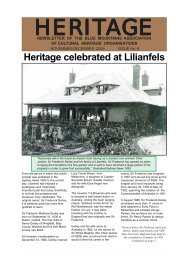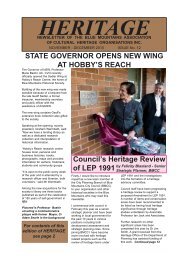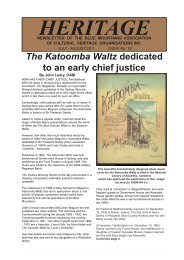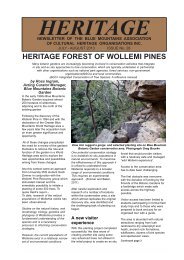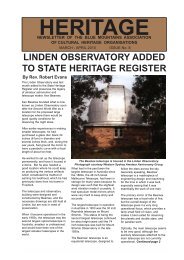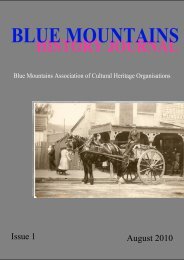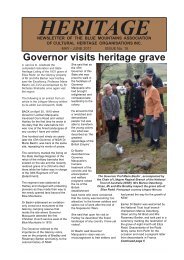Blue Mountains History Journal Issue 2
Blue Mountains History Journal Issue 2
Blue Mountains History Journal Issue 2
Create successful ePaper yourself
Turn your PDF publications into a flip-book with our unique Google optimized e-Paper software.
<strong>Blue</strong> <strong>Mountains</strong> <strong>History</strong> <strong>Journal</strong> 2; 2011<br />
OVER A CENTURY OF WORSHIP AT MEDLOW BATH<br />
Clair Isbister (deceased), Robert F. King 1 & Peter C. Rickwood 2<br />
1<br />
283 Hat Hill Road, Blackheath, NSW 2785<br />
2<br />
BEES, University of New South Wales, Sydney, NSW 2052<br />
p.rickwood@unsw.edu.au<br />
Abstract<br />
Religious observance in Medlow commenced at least as early as September 1894 when Church of<br />
England services were held in a cave on W.H. Hargrave’s land just below the present Hydro Majestic<br />
Hotel. Services were held there, and also in private homes, until St. Luke’s Church was opened in 1902<br />
and that continued to be the venue for the Anglican congregation until closure was enforced at the end<br />
of 2004. Roman Catholic worshippers met, sporadically, in the local hall, originally the Post &<br />
Telegraph Office then named Flanagan’s Hall and later, from November 1912, Rice’s Hall and they<br />
bought it in 1952 and held services therein until 1967. This paper deals with the history of these venues<br />
as used for religious observance.<br />
Key Words: St. Luke’s, Medlow, Cave Church, Anglican, Post Office, Catholic, <strong>Blue</strong> <strong>Mountains</strong><br />
Introduction<br />
Whilst the Hydro Majestic Hotel is certainly the most prominent building in Medlow Bath, across the<br />
railway line at 40a Railway Parade, midway between Sheila and Somerset Streets, is a much smaller<br />
historic building that from 1902 until 2004 was St. Luke’s Anglican Church (Figures 1 & 2). From its<br />
inception it was part of the Church of England district of Blackheath which eventually became a six<br />
church parish centred on St. Aidan’s at Blackheath (1884); the other congregations being at Hampton<br />
(St. Thomas’s, 1897 - Braga 1997, p.4) and Hartley (St. John the Evangelist, 1859) and Mount Victoria<br />
(St. Peter’s, 1875) and Mount Wilson (St. George’s, 1915) – Woodland (1999, p.8). Blackheath Parish<br />
is regarded as being strongly ecumenical and since 1969 has come under the Western Region of the<br />
Anglican Diocese of Sydney which is based at Parramatta.<br />
St. Aidan’s Church in Blackheath provided the clergy for worshippers at St. Luke’s which, being 5.3<br />
km (c.3.3 miles) to the south in the adjoining village of Medlow Bath, was regarded by the Church of<br />
England as a border community. Being, for many years, the only venue for religious observance in<br />
Medlow Bath it was attended by members of other faiths and was locally known as a community church.<br />
As such it was supported by Mark Foy, a prominent Catholic who nonetheless saw fit to support<br />
community activities of various sorts.<br />
A (photo – N. & E. Kirkland - 1990s)<br />
(BMHS photo 3875)<br />
Figure 1. Exterior of St. Luke’s Church 1990s<br />
B (photo – Jack et al. 2000)<br />
15 Back to Contents




